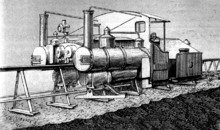Lartigue monorail

The Lartigue monorail was an early monorail developed by the French engineer Charles Lartigue around 1875 .
The principle
Lartigue is said to have come up with the idea of designing a railway with the same load transport principle from observing load-bearing camels . The monorail principle with hanging loads had advantages over the two-rail principle, especially on uneven and unpaved terrain.
The wagons had bins attached on either side of chassis with wheels running on a single rail . The rail was mounted on A-shaped supports that were continuously arranged one behind the other. There were additional lateral guide rails on the supports.
The steam locomotive on this line had a steam boiler with its own chimney on either side of the three drive wheels running on the rail . The two steam cylinders of the drive were between the boilers and the drive wheels. The well-known steam locomotive designer Anatole Mallet was also involved in the development of the locomotive .
history
Lartigue built a first railway based on this principle in Algeria over a distance of about 42 km to transport esparto grass through the desert from Oran to Damesne .
In 1886 Lartigue set up a section of his railway at an exhibition in London in the hope of obtaining licensees for his patents . Since at the same time there was an application from the population in the Irish county of Kerry for a railway line between Listowel and Ballybunion , the decision to build the railway according to Lartigue's idea should have resulted from this. The Listowel and Ballybunion Railway opened on March 1, 1888 and had a route length of ten miles (about 16 kilometers). The rail system had switches and also a turntable for turning the locomotive. The Listowel and Ballybunion Railway was in operation for 36 years until it was closed in 1924 because of the considerable damage from the Irish Civil War (1921-1923) and for economic reasons.
In France , a Lartigue railway was built in 1895 for passenger traffic between Feurs and Panissières . The covered wagons of this monorail had further open and free-standing seats on the roof, to which a staircase led up at the front. Wire cages were later installed on the roof of the vehicles to protect passengers . Due to financial difficulties and, in particular, technical problems, operations did not start. The operating company was liquidated on April 10, 1899. The whole of the rolling stock and the route was sold to a Lyon scrap dealer for 53,000 francs.
One of the last railways based on the Lartigue principle was the mine railroad built in 1924 for the Sierra Salt Corporation for magnesium mining in California . The cargo was moved from the Crystal Hills to the Trona loading station . The line ran over the rough terrain of the Salinas Valley. The railway proved itself for two years until the magnesium mining was switched to more modern methods.
In the Eastern Pyrenees , an ore railway for the Ria mines was built according to this principle, which was powered electrically according to a proposal by Werner von Siemens . Test routes were built in Guatemala and Peru . In Russia there have been attempts with a horse-drawn tram . Plans to build a Lartigue railway in Paris were not carried out.
present
In 2000, a short stretch of the Listowel and Ballybunion Railway was rebuilt in Listowel based on old templates. The line has been in operation since 2003, and the replica of the steam locomotive at the time is powered by a diesel engine in the tender's housing . The grounds also include a museum and park with relics from the historic Listowel and Ballybunion Railway .
See also
- Addis monorail
- Aldershot Narrow Gauge Suspension Railway
- Caillet monorail
- Ewing monorail
- Larmanyat monorail
- Lo Presti monorail
- Wiesenburg monorail
Web links
- Website of Listowel - Ballybunion Railway (English)
- Lartigue Monorail Locomotives (historical pictures, English)
Individual evidence
- ^ Neil Robinson: World Rail Atlas and historical summary. Vol. 7: North, East and Central Africa. World Rail Atlas Ltd., 2009. ISBN 978-954-92184-3-5 , page 12.
- ↑ Picture of the locomotive replica



